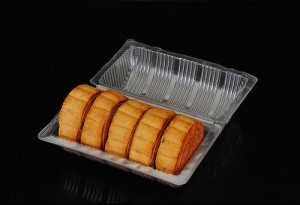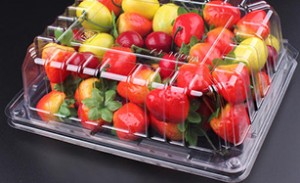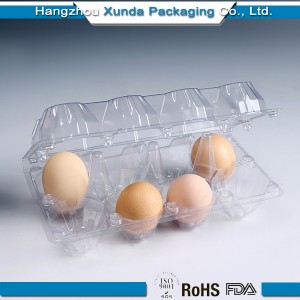What is The sustainable manufacturer? A 100% zero-waste-to-landfill facility? A company that consumes only renewable resources?
How about a firm that isn’t dictated by the axiom that the only responsibility a business has is to reward its shareholders, but perhaps, motivated to do well by its customers and the planet?
As we have heard countless times today, there is no silver bullet when it comes to sustainability; what works for one may not work for another. Success is dependent on context. But I believe if you just try to do something, that something could turn into an authentic silver bullet.
For the last 5 years, I have worked to make plastic clamshell packaging recyclable and recycled. And in 5 years, these containers went from being landfilled in 2009, to collected for recycling in 2013, to actually recycled in 2015.
While PET plastic water bottles are “recyclable,” PET plastic clamshells are not.
I began a blog that narrated my efforts to understand why plastic clamshells were not recyclable and what I could do to change that. Titled “Recycling in America,” it includes all my emails with Waste Management, the Integrated Board of Solid Waste Management, the US EPA, the Society of Plastics Industry, and pretty much everyone in between who had some type of knowledge on recycling.
After several months of learning about plastics recycling, we were advised to send our PET clamshells to our local recycler to see if the Near-Infrared automated sorting system would sort our containers with the PET bottles.
A week later I got a call from the recycler: he had tested our clamshells; they were sorted with PET bottles. Hurray! This means that PET clamshells could be sorted with PET bottles via NIR Systems. This means that plastic clamshells are not not recycled because issues with automated sortation.
A couple days later I got a call from the Sustainable Packaging Manager at Walmart Canada. She had found my blog while researching clamshell container recycling and wanted me to join a working group on PET recycling. Canada has extended producer responsibility legislation on the books, which means that packaging “producers” are left with the bill of waste management, a tax usually bestowed upon tax payers. It is therefore in Walmart Canada’s interest to invest in the recovery of the packaging it puts on shelf so as to reduce the “fee” associated with hard to recycle packaging. So I complied all of the independent research I had done the last 6 months and went to Canada. And it was awesome. I got to work with PET stakeholders up and down the supply chain on identifying the barriers to PET clamshell recycling. I learned a lot.
I returned home and wrote a report on clamshell recycling and titled it, “The Truth about Blister & Clamshell Recycling in America with Suggestions for the Industry.” Therein I laid out what I believed to be the obstacles to clamshell recycling and steps the industry could take to overcome these obstacles.
Packaging that is easy to collect, transport, sort, clean, bale and resell/remanufacture enjoys the likelihood of being recycled because the cost of recycling is offset by the value of the recyclate. Styrofoam is not recycled, for example, because it costs too much to ship what is essentially comprised of 98% air and 2% resin. Curb side collection isn’t usually offered in rural communities, as the cost of door-to-door collection too expensive; these communities generally rely on drop off locations for recyclables, consolidating the source of collection to allow for more appealing logistics.
There also has to be “enough” of a certain packaging/material type generated in the waste stream to justify the collection and recycling of it. That is why PET bottles are popular for recycling— because so many bottles of like material and design are manufactured each year and available for recycling.
To make the case for recycling PET clamshells with PET bottles, we have to understand the supply and demand realities for virgin and recycled PET.
NAPCOR, the PET industry’s trade group, says the capacity for PET recycling outweighs the supply, 3:1. This means that there are not enough PET bottles being collected post-consumer to meet the demand of the recyclers.
NAPCOR’s 2011 report reads, “The US now has capacity to process more PC PET packaging than the amount collected. That means that in 2012, even if no PET bales are exported these reclamation assets will be short of material. Investments in these assets are substantial and arguably the most sophisticated in the world…without reclamation plants there is no PET recycling, and these new plants are essential if respectable PET recycling rates are to be achieved. But without additional collection efforts or new streams of material, the increased capacity will only serve to drive prices to unsustainable levels” (NAPCOR, 2011).
Recycling PET clamshells, I argue in my Report, would add to the amount of PET available to recyclers, balancing the supply/demand imbalance that characterizes the market.
If we are going to recycle PET clamshells with PET bottles to increase the material available for recyclers, we have to confirm that clamshells wont be a contaminate to the PET bottle stream. The PET bottle industry has invested a lot of time and money into recycling and developed sophisticated collection, sortation, baling, and reprocessing methods that work to meet their buyers’ specs. Adding PET clamshells to the bottle-recycling stream must therefore ensure that the quality of the recyclate isn’t compromised.
I had heard that one of the obstacles to recycling clamshells with bottles is that the two packages have different intrinsic viscosities; this can be understood as a material’s integrity and ability to withstand stress. Plastic bottles holding carbonated beverages, for instance, need to have a high IV to allow the bottle to be handled and not break, whereas plastic thermoforms holding your takeout don’t need to have as high of structural performance properties. Every time plastic goes through a conversion process like recycling, IV is sheered off, compromising the “give” of the container.
Another concern with recycling PET clamshells with bottles is labels and adhesives used on clamshell containers can be more coercive than those used on bottles, gunking up the cleaning process.
As illustrated in this Report, the recycling of clamshells depends on the ability to collect, transport, sort, clean, bale, and remanufacture material into new products in an economically competitive way. Issues such as adequate supply and demand and investment in sorting and reprocessing technologies need to be addressed if we as an industry plan on the inclusion of clamshells in our recycling infrastructure.


